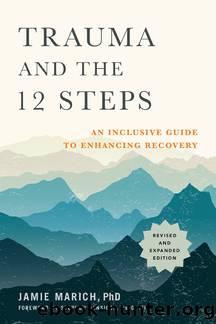Trauma and the 12 Steps, Revised and Expanded by Jamie Marich

Author:Jamie Marich [Marich, PhD, Jamie]
Language: eng
Format: epub
ISBN: 9781623174699
Publisher: North Atlantic Books
Published: 2020-05-13T00:00:00+00:00
Mindful, Bodyful Coping Strategies
When I do trainings on trauma-sensitive addiction treatment, I use the phrase coping skills a hundred times because the phrase is so important. The reality of recovery—especially for someone with trauma concerns—is that more unpleasant emotions, thoughts, and issues will surface, the longer the alcohol or drugs have been out of the system. This idea makes total sense to anyone who has ever gone through recovery or watched people go through the process. If you take away people’s numbing agent, they are going to start feeling and experiencing with full force, and having healthy coping skills to deal with that process is essential. If the phrase coping skills doesn’t sit well with you, synonyms include distress tolerance strategies, self-soothing, or affect regulation techniques. Whatever you call the actions you require in order to manage and handle what life throws at you in as healthy and adaptive a manner as possible, they will work. Although many of the twelve-step ideas discussed in the previous section can serve as positive coping skills to help a recovering person stay stable through adjustments, more help is often needed for coping. Skills that make use of the whole self—especially the body, and as many senses as possible—are the most successful.
In this section I cover and give examples of the major skill categories I teach my clients—grounding, breath work, pressure points, muscle relaxation, mindfulness, yoga, other embodied approaches, and the expressive arts. If you are a clinician with a willingness to first practice these skills yourself, my hope is that you can integrate these tools into your practice immediately. Most if not all can be taught in groups, as long as you allow time for some questions and discussions afterward about how people may need to modify the skills. The number one thing that makes a skill trauma-informed is your willingness to modify it for the person you serve. Reading skills out of a book only goes so far. These scripts usually don’t take the individual experience of the person into account. For example, an exercise you found online may have you do a certain breath with a particular hold strategy for eight to ten repetitions. The person may only be able to do one or two repetitions at first without the hold, and that is more than okay. Start with what a person can do and then work from there.
All these skills are also appropriate for sponsors or general members of recovery fellowships to share with others. The imperative is that you first try them yourselves and if you feel in over your head with certain skills, know when it’s best to have a person consult with a professional like a therapist or a yoga or meditation teacher in the community. The best practices for sharing the skills that follow in a trauma-informed setting include:
Eyes can stay open during all of the exercises.
Time in the exercise is variable—even if a description you read says five minutes or eight to ten rounds of a practice, know that you can cut down the time so people can adjust.
Download
This site does not store any files on its server. We only index and link to content provided by other sites. Please contact the content providers to delete copyright contents if any and email us, we'll remove relevant links or contents immediately.
| Adult Children of Alcoholics | Alcoholism |
| Drug Dependency | Gambling |
| Hoarding | Obsessive Compulsive Disorder (OCD) |
| Sexual | Smoking |
| Substance Abuse | Twelve-Step Programs |
The Hacking of the American Mind by Robert H. Lustig(3580)
Right Here, Right Now by Georgia Beers(3497)
Fingerprints of the Gods by Graham Hancock(3213)
Goodbye Paradise(2964)
Bad Pharma by Ben Goldacre(2730)
Happiness by Matthieu Ricard(2524)
More Language of Letting Go: 366 New Daily Meditations by Melody Beattie(2444)
The Social Psychology of Inequality by Unknown(2311)
Drugs Unlimited by Mike Power(2192)
The Plant Paradox by Dr. Steven R. Gundry M.D(2040)
Confessions of a Shopaholic by Sophie Kinsella(1865)
Borders by unknow(1785)
Make Love Not Porn by Cindy Gallop(1751)
Dry by Augusten Burroughs(1688)
Stop Being Mean to Yourself: A Story About Finding the True Meaning of Self-Love by Melody Beattie(1656)
Getting Off by Erica Garza(1619)
Yoga and the Twelve-Step Path by Kyczy Hawk(1533)
Weed, Inc. by Ben Cort(1512)
Unmasking Male Depression by Archibald D. Hart(1507)
